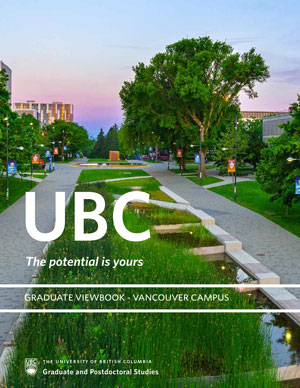Corey Nislow
Research Classification
Research Interests
Relevant Thesis-Based Degree Programs
Affiliations to Research Centres, Institutes & Clusters
Research Options
Research Methodology
Recruitment
Complete these steps before you reach out to a faculty member!
- Familiarize yourself with program requirements. You want to learn as much as possible from the information available to you before you reach out to a faculty member. Be sure to visit the graduate degree program listing and program-specific websites.
- Check whether the program requires you to seek commitment from a supervisor prior to submitting an application. For some programs this is an essential step while others match successful applicants with faculty members within the first year of study. This is either indicated in the program profile under "Admission Information & Requirements" - "Prepare Application" - "Supervision" or on the program website.
- Identify specific faculty members who are conducting research in your specific area of interest.
- Establish that your research interests align with the faculty member’s research interests.
- Read up on the faculty members in the program and the research being conducted in the department.
- Familiarize yourself with their work, read their recent publications and past theses/dissertations that they supervised. Be certain that their research is indeed what you are hoping to study.
- Compose an error-free and grammatically correct email addressed to your specifically targeted faculty member, and remember to use their correct titles.
- Do not send non-specific, mass emails to everyone in the department hoping for a match.
- Address the faculty members by name. Your contact should be genuine rather than generic.
- Include a brief outline of your academic background, why you are interested in working with the faculty member, and what experience you could bring to the department. The supervision enquiry form guides you with targeted questions. Ensure to craft compelling answers to these questions.
- Highlight your achievements and why you are a top student. Faculty members receive dozens of requests from prospective students and you may have less than 30 seconds to pique someone’s interest.
- Demonstrate that you are familiar with their research:
- Convey the specific ways you are a good fit for the program.
- Convey the specific ways the program/lab/faculty member is a good fit for the research you are interested in/already conducting.
- Be enthusiastic, but don’t overdo it.
G+PS regularly provides virtual sessions that focus on admission requirements and procedures and tips how to improve your application.
ADVICE AND INSIGHTS FROM UBC FACULTY ON REACHING OUT TO SUPERVISORS
These videos contain some general advice from faculty across UBC on finding and reaching out to a potential thesis supervisor.
Supervision Enquiry
Great Supervisor Week Mentions
Corey Nislow has been a very great supervisor and mentor. From my first day in UBC till now, he has always supported me. He provided an enabling and supportive environment for me to succeed in my PhD study and research. Importantly, he believes in me and answers whenever I needed his attention and/or support. In fact, I never regretted having him as my supervisor. He's the best!
Graduate Student Supervision
Doctoral Student Supervision
Dissertations completed in 2010 or later are listed below. Please note that there is a 6-12 month delay to add the latest dissertations.
Advances in genomics and drug discovery have been accelerated by the introduction of new technologies for screens of increasing complexity. A key test bed for these technologies is yeast (Saccharomyces cerevisiae), a valuable experimental model for understanding the mechanism of action (MOA) of compounds. Unfortunately, some of these screening approaches are, by necessity, biased, while others may not be suitable to address the intended research questions. This thesis used the unbiased yeast chemical genomics and phenomics tools to investigate cellular response to diverse drugs, toxins and mycoparasite-prey interactions. First, I characterized the genome-wide effects of N-nitrosamines and their metabolites, and revealed diverse evolutionarily conserved genes and pathways that mediate their toxicity, including arginine biosynthesis, DNA damage repair, mitochondrial genome integrity and vacuolar protein sorting. I further showed that overexpression of ARG3 (ornithine carbamoyltransferase) confers resistance to N-nitrosamines.In my second project, I identified candidate genes and pathways that could mediate interactions between two yeasts. I observed that resistance and sensitivity to predation by Saccharomycopsis schoenii could be time-dependent, and identified Saccharomyces cerevisiae deletion strains (hits) that were resistant and sensitive to S. schoenii. Genes lacking in the resistant strains are involved in cell wall integrity, arginine/lysine biosynthesis, and oxidative stress response. Conversely, the sensitive strains lack genes involved in endocytosis, vacuolar protein sorting, and cell size regulation.The third project provided data that can help define MOA of anthracycline chemotherapeutics using a multipronged approach. The data showed that some anthracyclines (doxorubicin, daunorubicin and epirubicin) exhibited higher potency in cells grown on glycerol versus glucose media. It further indicated that doxorubicin and daunorubicin MOA may involve mitochondrial processes that are not linked to mitochondrial DNA. I uncovered a spectrum of anthracycline response profiles, and showed that cellular effects of anthracyclines can be distinguished. Using whole genome sequencing, I identified mutations from doxorubicin-resistant clones, and showed that overexpression of ARL1 (ADP ribosylation factor like GTPase 1) and SSL2 (member of RNA polymerase transcription factor TFIIH complex) confers resistance to anthracyclines. Together, my work characterized candidate genes and pathways that could be required in cellular response to chemical perturbation.
View record
Spinal cord injury is a devastating condition with variability in injury mechanisms and neurologic recovery. Spinal cord impairment is measured and classified by a widely accepted standard neurologic examination, however this examination is extremely challenging to conduct due to the fact that patients are often sedated, unconscious, or have multiple injuries. The lack of objective diagnostic or prognostic tools is a barrier for clinical trials. Biological markers (biomarkers) are promising as they represent an unbiased approach to classify injury severity and predict neurologic outcome. MicroRNAs are attractive biomarker candidates in neurological disorders due to their stability in biological fluids, conservation between humans and model mammals, and tissue specificity. These features of microRNAs motivated my research to identify the changes in expression of microRNAs following different injury severities in human patients with spinal cord injury, as well as in a large animal model of spinal cord injury using pigs. In Chapter 1, I provide background on the diagnosis and prognosis of spinal cord injury and discuss the current status of biomarkers for spinal cord injury. In Chapter 2, I provide the historical context for the use of animal models for studying spinal cord injury and review the current status of such animal models and injury paradigms in spinal cord injury research. In Chapter 3, I used a porcine model of thoracic spinal cord injury to study the effects of injury severity on microRNA expression. I identified a set of microRNAs that are diagnostic for injury severity and prognostic for behavioural and histological outcome. In Chapter 4, I identified changes in microRNA expression following acute spinal cord injury in a cohort of 44 human patients. I identified a set of microRNAs that are diagnostic for baseline injury severity and prognostic for neurologic outcome. These data describe the alterations in the microRNA profiles following acute spinal cord injury and identify a common set of microRNAs that can be used as diagnostic and prognostic tools. Furthermore, the data obtained and analyzed in pigs and humans with spinal cord injury provides a reference data set for future work as well as for correlative pig-human investigations.
View record
Master's Student Supervision
Theses completed in 2010 or later are listed below. Please note that there is a 6-12 month delay to add the latest theses.
In this study 180 patients were consented and enrolled for pharmacogenomic testing based on their current antidepressant/antipsychotic usage. Samples from patients were genotyped by PCR, massARRAY, and targeted for next generation sequencing. We also conducted a quantitative, frequency-based analysis of participants’ perceptions using simple surveys. Pharmacogenomic information, including medication changes and altered dosing recommendations were returned to the pharmacists and used to direct patient therapy. Overwhelmingly, patients perceived pharmacists/pharmacies as an appropriate healthcare provider to deliver pharmacogenomic services. In total, there were 81 medication changes in 33 unique patients, representing 22% of all genotyped participants. We performed a simple drug cost analysis and found that medication adjustments and dosing changes across the entire cohort added $24.15CAD per patient per year for those that required an adjustment. Comparing different platforms, we uncovered a small number (1.7%) of genotype discrepancies, none of which impacted medication suggestions. We conclude that: 1) Pharmacists are competent providers of pharmacogenomic services. 2) The potential reduction in adverse drug responses and optimization of drug selection and dosing comes at a minimal cost to the health care system. 3) Changes in drug therapy, based on PGx tests, result in inconsequential changes in annual drug therapy cost with small cost increases just as likely as costs savings. 4) Pharmacogenomic services offered by pharmacists are ready for wide commercial implementation. This thesis details the methods and results from this study in relation to pharmacogenomics as a concept and its practice across British Columbia and Canada.
View record
The Yeast Knockout (YKO) collection has provided functional annotations from thousands of genome-wide screens. As an unintended consequence however, ~90% of gene annotations are derived from a single genotype. The nutritional auxotrophies in the YKO are of particular concern as they have phenotypic consequences. To address this issue, repaired ‘prototrophic’ versions of the YKO collection have been constructed; the first by introducing an ARS-CEN plasmid carrying wildtype copies of the auxotrophic markers (Plasmid-Borne, PBprot), and the second by backcrossing (Backcrossed, BCprot) to a strain wildtype for the auxotrophies. To systematically assess the impact of the auxotrophies, genome-wide fitness profiles of the prototrophic and auxotrophic YKO collections were compared across a diverse set of drug and environmental conditions. Comparative fitness profiling for the prototrophic collections revealed genotypic and strain-construction-specific phenotypes. The PBprot collection exhibited fitness defects associated with plasmid maintenance, while the BCprot collection’s fitness profiles were compromised due to strain loss resulting from nutrient selection steps during strain construction. The repaired prototrophic versions of the YKO collection did not restore wildtype behaviour and had additional experimental liabilities. Neither prototrophic collection compensated for gaps in gene annotation resulting from the auxotrophic YKO genetic background. To remove marker bias and expand the experimental scope of current deletion libraries, construction of a bona fide prototrophic collection from a wildtype strain will be required.
View record
Hypoxia, the state of reduced oxygen, is a microenvironment found in many solid tumours and is correlated with an increased risk in patient mortality. This is due to an increase in resistance to radiotherapy and chemotherapy as well as a decrease in drug efficacy. The mechanisms and cellular factors (gene products) associated with this reduced chemotherapeutic efficacy in hypoxia remains unclear. This research looks to identify cellular processes and pathways that cancerous cells are able to exploit in order to survive and thrive in this microenvironment. The eukaryotic model baker’s yeast Saccharomyces cerevisiae combined with a genome-wide approach was used to screen the yeast knockout collection for specific genotypes that are sensitive to the hypoxic environment alone, and in combination with commonly used chemotherapeutics. Pathways and processes identified in these screens include transcriptional regulation, cytoskeleton maintenance, ribosomal biogenesis, macromolecular complex assembly and the heat shock response. The combination of heat and hypoxia was found to result in a synergistic effect that drastically affected cell fitness. DNA-damaging chemotherapeutics screened in hypoxic conditions showed reduced efficacy. Genotypes most sensitive to drugs in the hypoxic environment fall into Gene Ontology (GO) terms categorized in the response to the specific mechanism of the drug. This includes DNA repair processes such as homologous repair, post-replicative repair and mismatch repair. The mechanistic specificity uncovered in these screens suggests that the hypoxic environment exacerbates drug-specific stresses, and the identified genotypes highlight gene products and pathways critical for these responses. Cell survival and success in this microenvironment therefore requires adaptations to these exacerbated stresses, a phenomenon successfully accomplished by resistant tumour cells. This research contributes to our understanding of cellular biology under this cancer microenvironment, and provides data to highlight the challenges in using chemotherapeutics to treat tumours.
View record
As of 2007, over 30 million hectares are affected by salinization resulting in poor crop yield and a reduction of food production. Reversing salinization of soil is an expensive and long term process. The bioengineering of plants to better cope with salinization of the soil is an ongoing research effort. Hortaea werneckii is an extremely halotolerant (salt tolerant) black yeast and can grow in the absence of salt or in almost saturating conditions (5M NaCl). Its natural ecological niche is the solar salterns of Slovenia which have range of environmental extremities such as the salt concentration, low oxygen, and high UV intensity. Recently it was discovered that this yeast has had recent genome duplication and 90% of the proteins exist in duplicate. The whole genome duplication and the extreme NaCl tolerance of H. werneckii provide an interesting model to investigate molecular mechanisms involved in salt stress. In this study, H. werneckii’s genome assembly is improved (increased contiguity) and used for subsequent molecular experiments such as MNase-seq and RNA-seq. These experiments were used to examine differences of gene expression and the corresponding chromatin architecture across a range of saline conditions to determine important molecular mechanism in salt tolerance. H. werneckii increases respiration in response to salt stress exemplified by the upregulation of mitochondrial associated genes and antioxidant defense genes. Additionally, H. werneckii genes encoding zinc transporters and genes involved in glycerol assimilation were increased in response to high salt. The chromatin landscape of some of these genes differs from other yeasts such as S. cerevisiae. Using next generation sequencing and third generation sequencing a more complete picture of H. werneckii’s mechanisms of salt tolerance has been obtained while also creating an extensive data-base for future research.
View record
News Releases
-
Event: Unboxing of space-travelling yeast and algae (10 Jan 2023)
If this is your researcher profile you can log in to the Faculty & Staff portal to update your details and provide recruitment preferences.



